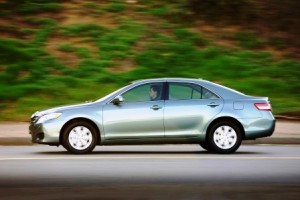Perhaps one of the most shocking facts about Toyota’s raging safety crisis is the way a problem with a seemingly minor part, such as an accelerator pedal, can create havoc across the maker’s entire line-up.
Initially, the maker said 2.3 million vehicles would have to undergo repairs due to a sticky accelerator. But since then, Toyota has expended that number to more than 4 million, as it as added vehicles sold in other parts of the world.
That, says analyst Joe Phillippi, of AutoTrends Consulting, is one of the risks of using common parts in a wide range of products. The trade-off is that when things go right, this not only slashes the cost of engineering a component but yields potentially huge economies of scale as volumes rise from hundreds of thousands into the millions.
And it’s not only individual parts that makers are sharing but entire product platforms. Take the 2011 Ford Focus, which the automaker unveiled at last month’s Detroit Auto Show. In years past, Ford developed one version of the compact model for the U.S. and another in Europe. But the ’11 Focus will be sold, with only minor modifications, around the world, with 80% of the parts in the U.S. version shared with the European Focus, says Derrick Kuzak, Ford’s director of global product development.
And that reveals only part of the story. Eventually, as many as 10 different Ford products will be based off the Global C platform Focus is based on. They will include a small “people mover” called C-Max, as well as a yet-unnamed compact model destined for Ford’s struggling Mercury division.
Ford isn’t the only maker moving in this direction. Far from it. In fact, Japanese manufacturer used the concept of platform sharing to help them achieve their growing dominance. Another benefit is the ability to produce a wide variety of models in a single plant, so that when demand for one model line dips, production of another, better-selling line can be ramped up with minimal effort.
As the Detroit Three struggle to increase their competitiveness, they’re abandoning a number of old platforms in favor of new “architectures” that can be widely shared. Now, they have tried that before. Back in the mid-1980s, General Motors rolled out an array of midsize models, dubbed the A-Cars. The problem was that they not only shared the same underlying platform but looked virtually identical. A critical cover story in Fortune magazine noted that the only way to tell them apart was their divisional logos, which was the source of the term, “badge engineering.”
But few would confuse the Focus and C-Max — or the Chevrolet Equinox and Cadillac SRX, two GM crossovers with very similar platforms.
According to a new study by the consultancy Grant-Thornton, Detroit makers will collectively trim the number of platforms they rely on by at least 39% by 2014, and that could jump as high as 50%, suggests James Ricci, the firm’s Director of Advisory Services.
Today, about 20% of the products GM sells in North America rely on shared global platforms. By 2014, Grant-Thornton expects that to increase to 60%. Take the new Global Alpha rear-drive platform due to debut just before mid-decade. It will serve as the underlying architecture for models as diverse as the next-generation Chevrolet Camaro and the 2013 Cadillac CTS.
Ford will climb to 64% of its line-up using common global platforms, and at Chrysler, the tally will be roughly half of its offerings, as it comes to depend more and more heavily on products and platforms shared with its new Italian partner, Fiat.
The impact can be measured another way. In 2009, the typical platform accounted for about 158,000 sales in the U.S. market. But, says Ricci, “hat’s expected to double to more than 300,000 a platform by 2014.”
Toyota will press even further, increasing sales from 200,000 per common platform to more than 450,000, the consultancy predicts. The maker already shares common or virtually identical platforms on such popular models as the Camry, Solara, Avalon and Highlander, among other models.
“Toyota’s current situation begs the question whether global platforms are really a good thing,” cautions Ricci. But, in the long-run, Grant-Thornton’s research says, “yes.” That is, as long as steps are taken to minimize potential problems.
The good news is that sharing underlying platforms can reduce the time it takes to bring a new product to market, improving the responsiveness of a manufacturer to shifting consumer tastes and regulatory demands. But some industry analysts believe that part of the problem Toyota is facing is that it has been moving so fast it has been relying too much on computer simulations rather than traditional, real-world testing of parts, components and vehicles.
Significantly, while U.S. regulators have allowed makers to increase the use of digital crash testing, real prototypes must be used final safety validation tests.
The trend towards shared platforms seems unavoidable and, if handled properly, everyone wins, since consumers will get a wide variety of models at a potentially lower cost. But the Toyota crisis is certain to underscore the need to head off problems before parts, components and platforms get into production. If a defect is only discovered after the fact, the potential cost could be huge, both to the balance sheet and to a manufacturer’s reputation.

